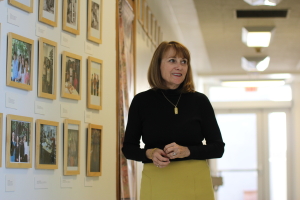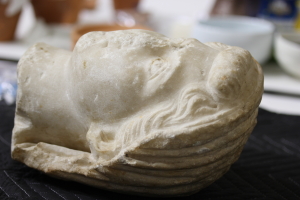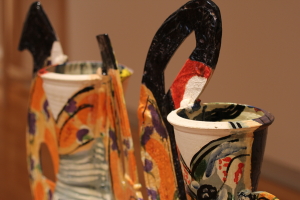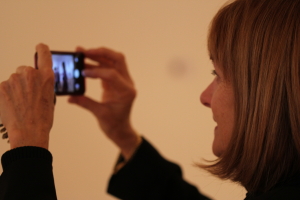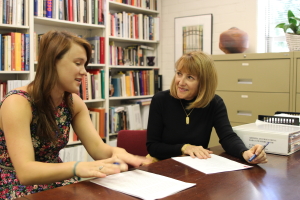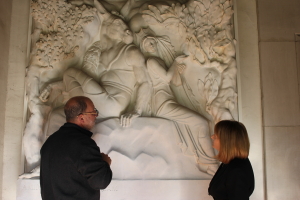Mary Davis MacNaughton ’70 has come full circle. The professor of art history and director of the Ruth Chandler Williamson Gallery began her formal studies as a student at Scripps College in the 1960s. Then she went on to earn a PhD in Art History at Columbia University, worked at the Metropolitan Museum of Art, and traveled extensively for research. Yet, MacNaughton ultimately returned to her roots at her alma mater to teach, guide, and mentor Scripps students in the visual arts.
MacNaughton’s role is a multifaceted one. When she isn’t planning an exhibition, working
with interns, or raising funds to conserve Scripps’ permanent art collection, you can often find her mentoring future leaders of the art world. Megan Goldman ’15 recently met with MacNaughton to discover what keeps her going—and what keeps her up at night.
Megan Goldman: What are some of your favorite memories about attending Scripps?
Mary MacNaughton: I loved so much about my Scripps experience—from the friendships I made to the courses I took. I remember that the Humanities lectures at 8 a.m. in Balch were hard to wake up for, but so thought-provoking.
Goldman: How does it feel to teach at your alma mater?
MacNaughton: It is a joy to teach at Scripps, where my intellectual journey began, and where I still relish exploring ideas with students today. At Scripps, I learned to think across disciplinary boundaries and to approach problems from different perspectives. Perhaps that’s why I’m drawn to art conservation, as it lies at the intersection of art, humanities, and science.
Goldman: In addition to your work with the Gallery, how do you make an impact at Scripps?
MacNaughton: I like to help students find their career paths, and I encourage them to network, especially with Scripps alumnae. There are many accomplished Scripps alumnae in the visual arts, including art critics, artists, art dealers, curators, and conservators.
I also keep in touch with my former students who are finishing graduate school or are working in galleries and museums. It gives me great pleasure to see them move ahead in their careers and to hear about their families.
Goldman: In addition to teaching and advising, you also oversee several interns. What are some highlights of working with interns?
MacNaughton: I enjoy directing internships at the Williamson Gallery, and one of the goals is to introduce students to different careers in the visual arts. During summers, I often take interns into Los Angeles to meet art critics, curators, conservators, and gallery directors. Many times we have gone to the conservation labs at the Los Angeles County Museum of Art and the Getty Villa.
Paid interns at the gallery meet leading professionals in the visual arts and work in the studios of highly regarded conservators. It is not surprising that Scripps alumnae are competitive in the job market, as they already have had experiences that most students don’t get until graduate school.
Goldman: What’s the best career advice you ever received?
MacNaughton: Build positive relationships with colleagues, as these can lead to future collaborations.
Goldman: What are the greatest challenges for students pursuing the arts today?
MacNaughton: Making a career in the arts has never been easy, but it is possible for those who are motivated, and it brings high job satisfaction. I like to help students find their career path and encourage them to network, especially with Scripps alumnae.
It is important to begin early and gain experience through internships. Doing excellent work in each job is essential, as the art world is small, and references are often key to getting the next opportunity.
Goldman: What’s the best part of your job?
MacNaughton: I enjoy teaching and advising immensely. I also like to see students use the Scripps permanent collection, whether they are in Professor Coats’ seminar in Japanese prints, or Professor Gonzales-Day’s studio course in photography, or Professor Phyllis Jackson’s seminar in African American art.
Goldman: What is the greatest challenge of your job?
MacNaughton: It is a challenge to conserve public sculptures on campus. Art conservation interns have done an excellent job cleaning and polishing bronze sculptures on campus, from the La Semeuse medallions at Honnold Gate to Albert Stewart’s fawn in the Chinese garden.
Goldman: What is your guilty pleasure?
MacNaughton: Besides eating dark chocolate, my pleasures are throwing clay on the wheel and pulling prints from the press.
Goldman: What’s something readers may not know about you?
MacNaughton: I like to swim laps in the Scripps pool; swimming is a good workout and a way to meditate.
Goldman: And finally, what keeps you up at night?
Future plans! Right now, I’m planning Williamson Gallery exhibitions for 2016 and 2017. I recently returned from a research trip to Mexico City, where I met with writers, visited artists, and selected works for an upcoming exhibit in conjunction with the Getty Foundation. I also raise funds to conserve artwork and support paid gallery internships at Scripps.


